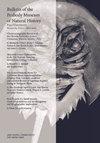First Record of a Small Juvenile Giant Crocodyliform and its Ontogenetic and Biogeographic Implications
IF 0.9
4区 哲学
Q2 BIODIVERSITY CONSERVATION
引用次数: 1
Abstract
Abstract Deinosuchus is a genus of large crocodylian that inhabited North America during the Late Cretaceous. This massive predator has become one of the most well-known prehistoric organisms, with a considerable amount of literature on its biogeography, ecology, and evolution published. However, ontogenetic changes of Deinosuchus and other species of extinct large, predatory crocodyliforms have remained poorly understood because of a lack of remains known from juvenile individuals and issues surrounding the ability of histological analysis of adult material to provide information on yearly growth. Here, I describe a tooth from a juvenile Deinosuchus estimated at less than 1m in total body length. As the first reported specimen of a juvenile Deinosuchus, to the author's knowledge, in the literature, the new fossil evinces the extremely small size of young individuals of this taxon compared to adults more than 8 m and 3,500 kg. Furthermore, the tooth shows that some morphological discrepancies existed between the dentition of juvenile and adult Deinosuchus individuals, including the size of the nutritive region. In addition to being the first specimen of Deinosuchus from northeastern North America described in detail, the tooth emphasizes the biological extremes of attaining large body size in Deinosuchus and may add support to the hypothesis that the ontogeny of gigantic crocodyliforms was characterized by extended periods of juvenile growth.巨型鳄鱼幼兽的首次记录及其个体发生和生物地理意义
恐爪龙是生活在晚白垩纪北美洲的大型鳄鱼属。这种巨大的掠食者已经成为最著名的史前生物之一,出版了大量关于其生物地理学,生态学和进化的文献。然而,恐爪龙和其他已灭绝的大型掠食性鳄形动物的个体发生变化仍然知之甚少,因为缺乏已知的幼年个体遗骸,以及有关成年材料的组织学分析能力的问题,以提供有关年生长的信息。在这里,我描述了一颗来自幼年恐爪龙的牙齿,估计它的全身长度不到1米。据作者所知,这是文献中首次报道的幼年恐爪龙标本,新化石表明,与超过8米、3500公斤的成年恐爪龙相比,这一分类单元的年轻个体体型极小。此外,这颗牙齿还显示了幼年恐爪龙和成年恐爪龙之间存在一些形态上的差异,包括营养区域的大小。这颗牙齿除了是北美洲东北部第一个被详细描述的恐爪龙标本外,还强调了恐爪龙获得大体型的生物学极端,并可能支持巨型鳄形动物个体发育的假设,即其特征是长时间的幼年生长。
本文章由计算机程序翻译,如有差异,请以英文原文为准。
求助全文
约1分钟内获得全文
求助全文
来源期刊

Bulletin of the Peabody Museum of Natural History
BIODIVERSITY CONSERVATION-ECOLOGY
CiteScore
2.40
自引率
0.00%
发文量
6
审稿时长
>12 weeks
期刊介绍:
The Bulletin of the Peabody Museum of Natural History publishes original research based on specimens, artifacts and related materials maintained in the collections of the Yale Peabody Museum of Natural History’s curatorial divisions. The Bulletin is published twice a year, in April and October.
 求助内容:
求助内容: 应助结果提醒方式:
应助结果提醒方式:


